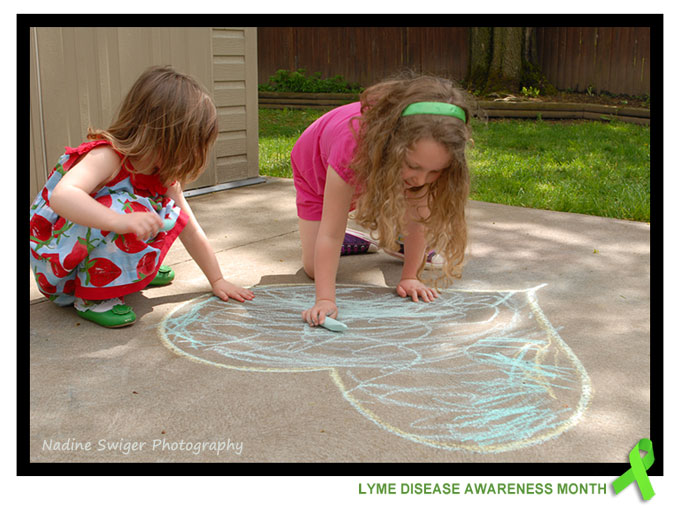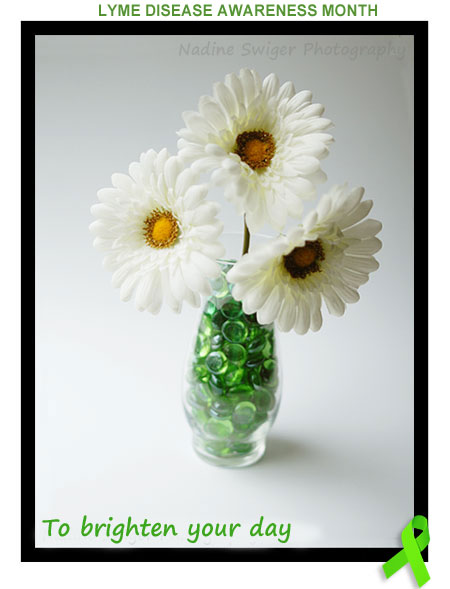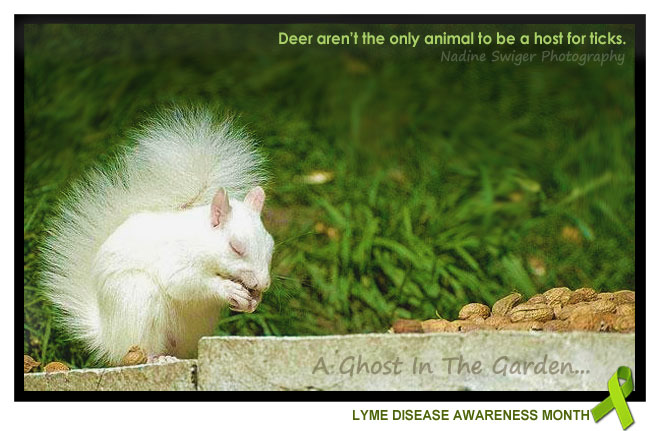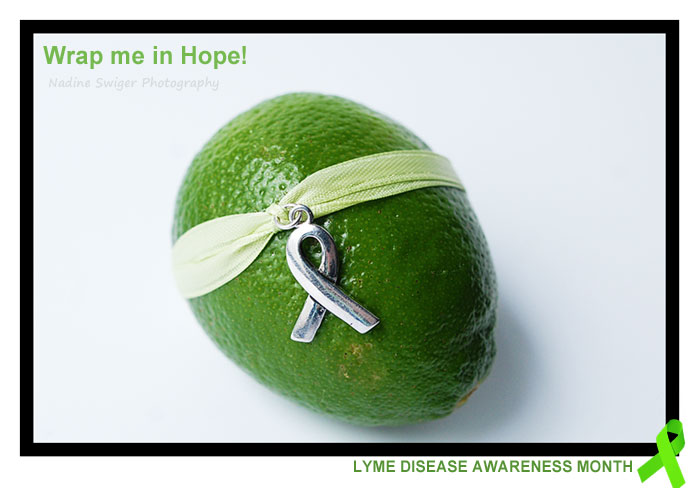Protect Your Kids….. Lyme Disease Awareness Photos
Day 5 : Lyme Disease Awareness Photos
MYTH : The only time you will need antibiotics is when you develop a bulls-eye rash.
This statement is FALSE!
_________________________________________________________________________________________
Actually a little less than 70% of people who have Lyme Disease ever saw the bulls-eye rash, 50% have no history of tick attachment, making Lyme disease trick to diagnose. Did you know that 25% of Lyme patients are children? Be sure to learn the fact to help protect your children.
Here are a list of what symptoms to look for in your child if you suspect Lyme Disease:
(According to lymedisease.org)
- severe fatigue unrelieved by rest
- insomnia
- headaches
- nausea, abdominal pain
- impaired concentration
- poor short-term memory
- inability to sustain attention
- difficulty thinking and expressing thoughts
- difficulty reading and writing
- being overwhelmed by schoolwork
- difficulty making decisions
- confusion
- uncharacteristic behavior
- outbursts and mood swings
- fevers/chills
- joint pain
- dizziness
- noise and light sensitivity
_________________________________________________________________________________________
For more information about Children and Lyme Disease visit: www.lymedisease.org/resources/children.html
_________________________________________________________________________________________
Chronic or Post….. Lyme Disease Awareness Photos
Day 4 : Lyme Disease Awareness Photos
MYTH : There is no such thing as Chronic Lyme | This statement is FALSE!
_________________________________________________________________________________________
Once you have been infected with Lyme Disease; the disease will always remain in your blood. If caught in the early stages, the disease can go into remission with the proper amount of antibiotics. The longer the disease is in your blood, the harder it is to treat and force the disease to go into remission. Chronic Lyme usually comes to patients who are in the late stage of Lyme disease.
Get the Facts!!! Demand to be properly treated.
The Twist on Lyme….. LD Awareness Photos
Day 3 : Lyme Disease Awareness Photos
MYTH : I can safely remove ticks by burning them out. | This statement is FALSE!
_________________________________________________________________________________________
The only safe way to remove a tick is to use a pair of tweezers. Place the tweezers as close to the skin as possible, pinch the tick’s head and slowly pull it straight out without twisting and breaking any body parts off; without touching the tick, place it in the ziploc bag. You will want to remove a tick as soon as you discover it, as the quicker to remove it, the less of a chance the tick will have to transfer any potential infections. When your in a tick infected area, high grassy area or in a wooded area, you should always carry a pair of tweezers and a ziploc bag in your pocket or purse.
_________________________________________________________________________________________
There are so many different myths about how to remove ticks, that are not safe!!
Matches or Lighter – NOT SAFE : If you burn their butts with a match/lighter, you might be encouraging the tick to burrow in even deeper to get away from the heat. In doing so, you add more stress to the tick to survive, which in turn has them creating more saliva that could increase your chances to get infected.
Another false method is to use petroleum jelly, kerosene, or nail polish remover to smother the tick. You could make them sick and throw up inside your body and potentially transmitting an infection to the host.
Twisting the tick counterclockwise to “unscrew” the tick from your skin. Again, you could make them sick, throw up inside your body and potentially transmitting an infection to the host.
_________________________________________________________________________________________
To see how to properly remove a tick, visit: http://video.about.com/firstaid/How-To-Remove-a-Tick.htm
Not all things Deer….. LD Awareness Photos
Day 2 : Lyme Disease Awareness Photos
MYTH : Deer Ticks are found only on deer and not dogs. | This statement is FALSE!
_________________________________________________________________________________________
Lyme disease is actually believed to have originated from white field mice.
Deer ticks hatch from eggs usually in the spring or summer, usually beginning in April. When born in their larvae state, they look like a tiny grain of sand as they are roughly 0.7mm or 0.025 inches long and having all six legs. They crawl to a place (usually high grass) and await a host to feed on. After one month, the larvae will molt into the nymph stage (size of a poppy seed and now has 8 legs) and can live up to 5 months after they are born without food before it dies from starvation or dehydration. Only about 10% of deer tick actually survive and find their first meal. They prefer to attach to a rodent (mice, chipmunks, squirrels) but will also attach to other animals like rabbits, birds, dogs, cats, deer and even humans. From there, the nymph usually will molt over the winter months and emerge into an adult (about the size of a sesame seed) in the spring, looking for it’s next meal. If one of those animals they first feed on are infected with Lyme Disease (or any of the tick-borne illnesses), the tick will be come infected and will spread the disease to the next animal it feeds on.
_________________________________________________________________________________________
To Find out more about Lyme Disease and how many cases of Lyme are in your area, visit: www.lymediseaseassociation.org
“Lyme” photos – Lyme Disease Awareness Month.
With the number of ticks on the rise, so is the number of people infected with atleast one tick-borne illness. May is National Lyme Disease Awareness month – get informed on how to protect you and your loved ones!
Throughout the month of May, I will be featuring a different photo each day that is inspired by “Lyme” and hopefully shed some light on the common myths about ticks and Lyme disease (both for humans and animals). I will also be addressing the other tick-borne diseases known as co-infections and hopefully if nothing else raise your awareness of a debilitating disease.
For many years I can remember hearding about Lyme Disease, but not knowing too much more about it than you can contract it from an infected tick bite. I knew the disease was something to take serious, but outside of that, I didn’t know too much more. Unfortunately six years ago, Lyme disease would become something I would learn to know a little too well.
Did you know a tick that is as small as a poppy seed (nymphal stage) is old enough to infect a human with Lyme disease? Take a moment to think about that next time you are at Dunkin Donuts getting a coffee or at your local bakery or grocery store; when you see the poppy seed bagels sitting on the shelve, imagine if one of those poppy seeds were actually an insect. Would you see it or feel it crawling on your skin?? Most people who have Lyme Disease, never saw the tick or even knew that they were bit. And only 50% or so even develop the bulls-eye rash after they are bit. According to the national Lyme Disease Association(LDA), it’s believed that over 225,000 people are infected each year and that number is growing in an alarming rate.
Lyme Disease does not discriminate against who it infects. You can have the strongest, most fit professional athlete brought to his knees in pain or the most innocent as a new born baby that may not be able to celebrate their first birthday. There is no formula to which the disease attacks; it just does what it does.
Watch this video that NewsChannel 8 from the Metropolitan Washington, D.C., region recently broadcast. It shows some of the smallest of ticks that can cause havoc on your immune system. Plus you can see first hand what the bulls-eye rash looks like:
Chart on how to protect yourself: http://lymedisease.org/pdf/protect_yourself.pdf








